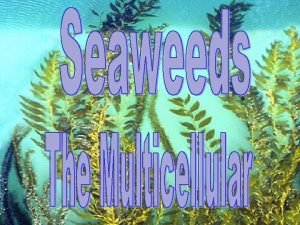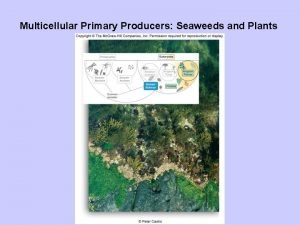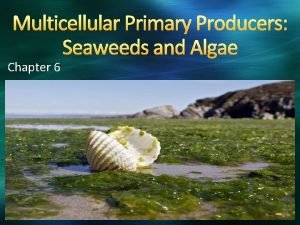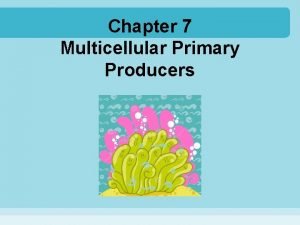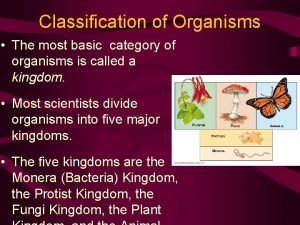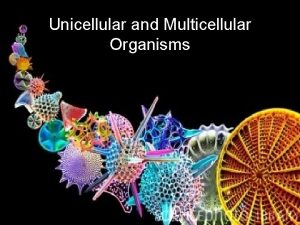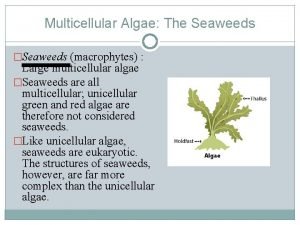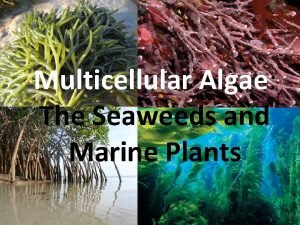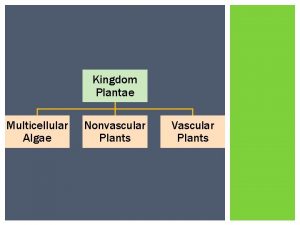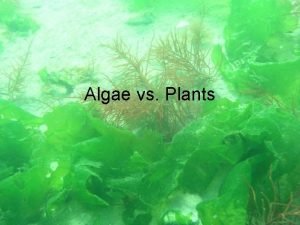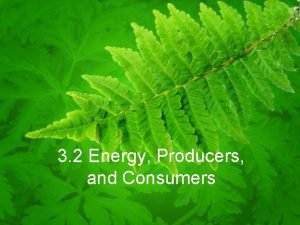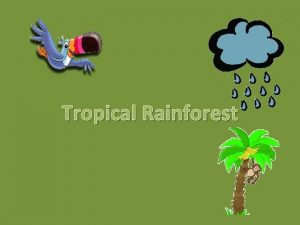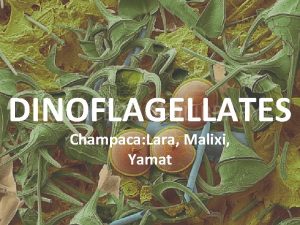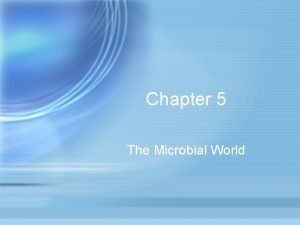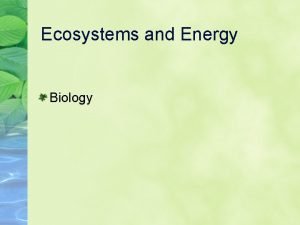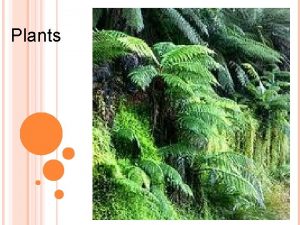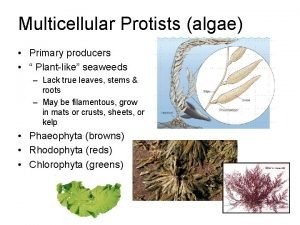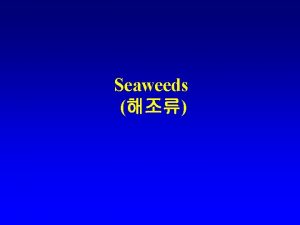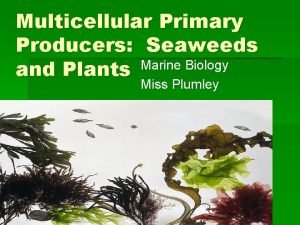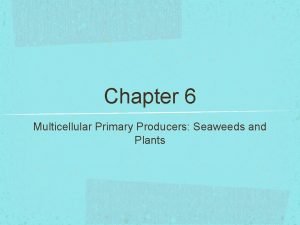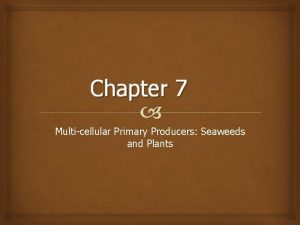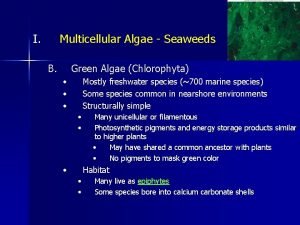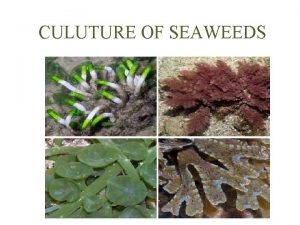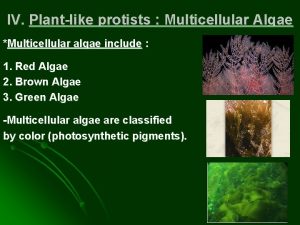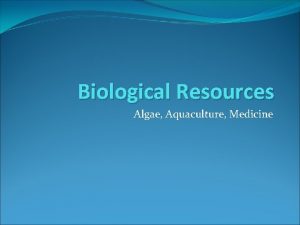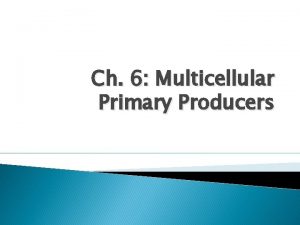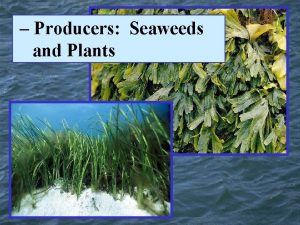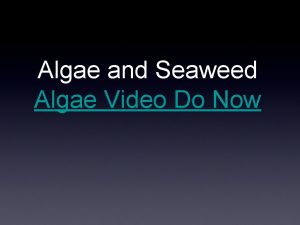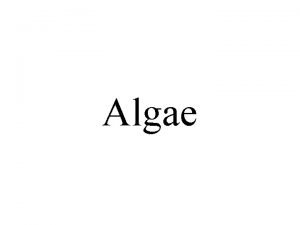Multicellular Primary Producers Seaweeds and Plants Multicellular Algae
























- Slides: 24

Multicellular Primary Producers: Seaweeds and Plants

Multicellular Algae: The Seaweeds (macrophytes) § A. General Structure § Seaweeds lack true leaves, stems and roots of plants § Instead they have…… § Thallus § Complete body § Blades § Leaf-like (no veins) flattened portions of the thallus § Pneumatocysts § Gas-filled bladders that keep the blades close to the sea surface. § Stipe § Location where blades originate from § Holdfast § Attaches the thallus to the bottom

Float – pneumatocyst

Multicellular Algae: The Seaweeds § B. Types of Seaweed § 1. Green Algae § Named for their green chloroplasts § Phylum Chlorophyta § Only 10% of the estimated 7, 000 are marine § Very closely related to plants. § Contain photosynthetic pigments

Multicellular Algae: The Seaweeds § B. Types of Seaweed § 1. Green Algae (continued) § Examples: § Volvox- colonial green algae shaped like a hollow ball. Contains hundreds and thousands of cells connected by bridges of cytoplasm. § Ulva- large and complex enough to qualify as seaweeds along with Brown algae.

Multicellular Algae: The Seaweeds § B. Types of Seaweed § 2. Brown Algae § Yellow-brown pigments (fucoxanthin) in addition to chlorophyll § Phylum Heterokontophyta § Most complex seaweeds § Grow on rocky shores and must be able to withstand wave action and daily tides

Multicellular Algae: The Seaweeds § B. Types of Seaweed § 2. Brown Algae (continued) § Examples: § Kelp § Anchored to the sea floor by root-like structures called holdfasts (not actual plant roots). § Grows fast (up to ½ meter a day) § Monterey Bay Aquarium: Kelp Forest Exhibit - Live Kelp Cam

Multicellular Algae: The Seaweeds § B. Types of Seaweed § 2. Brown Algae (continued) § Examples: § Rockweed § Common on Rocky shores on the Atlantic coasts of temperate North America and Europe

Multicellular Algae: The Seaweeds § B. Types of Seaweed § 3. Red Algae § Contain red pigments called phycobilins § Can live in deep water because they absorb blue and green light (the light that penetrates the deepest). § Most are soft bodies, but some are coralline algae (cell walls hardened by mineral deposits). § Coralline algae live and contribute to the structure of coral reefs. § These algae depend on water currents to bring gametes together.

Multicellular Algae: The Seaweeds § B. Types of Seaweed § 3. Red Algae § Examples: § Coralline algae § Has a thallus that is hard as a result of calcareous deposits contained within the cell walls

Multicellular Algae: The Seaweeds § C. Life History § Reproduction § A. Asexual § Fragments of thallus often grow into new individuals § Spores § Cells specialized for dispersal § Zoospores-spores that have flagella for movement § B. Sexual § Gametes from two individuals fuse so that the new generation contains genetic info from both parents § Sporophyte-produces haploid spores through meiosis § Gametophyte-produces haploid gametes

Multicellular Algae: The Seaweeds § Life History: § Get a text book and turn to page 107 -108 § Summarize the four types of life cycles demonstrated in Seaweeds § Make sure you understand the terminology

Multicellular Algae: The Seaweeds

Multicellular Algae: The Seaweeds

Multicellular Algae: The Seaweeds

Multicellular Algae: The Seaweeds § D. Economic Importance § Mariculture § Farming of seaweeds § Phycocolloids § Chemicals used in food processing and in manufacture of different products § Examples: § Algin-used as stabilizer for ice cream, cheese and toppings. Also prevents frostings from becoming dry. Used in making rubber products, paper, paints and cosmetics. § Carrageenan-obtained from Red Algae. Used in dairy products and puddings § Agar-used to protect ham, fish and meats during canning

Multicellular Algae: The Seaweeds § E. Other Importances § Shelter for juvenile fish, sea turtles, and inverts. § Food for juvenile fish, sea turtles, and inverts.

Multicellular Algae: The Seaweeds § Algae Paper § At least one page (you can do more) § Double spaced § Times New Roman § Heading is NOT double spaced § Find one economic importance of a specific species of seaweed (Food, medicine, ect)

Flowering Plants § Also known as Angiosperms § Have true stems, leaves, and roots § Few live in ocean (most live near) § Reproduction involves sporophyte and reproductive organ (flower)

Flowering Plants § A. Seagrasses § § § Only true marine flowering plant Evolved from land plants Horizontal stems called rhizomes that grow beneath sediment § Flowers very small and inconspicuous (no need to attract insects for pollination)

Flowering Plants § B. Salt-marsh plants § Halophytes § Salt-tolerant plants § Pickle weed § Cordgrasses § Not marine plants, but very salt tolerant § Do not tolerate total submergence of water § Salt glands in leaves excrete salt

Flowering Plants § C. Mangroves § Trees and shrubs adapted to live along tropical and subtropical shores § Feeding and living grounds for many juvenile fishes and invertebrates

Flowering Plants § C. Mangroves § Adaptations § Thick leaves to avoid water loss § Reproduction – seeds germinate while attached to parent; form seedlings shaped to stick in ground or float to new location.

Flowering Plants § Examples: § 1. Red mangrove § Rhizophora mangle § Prop roots § 2. White Mangrove § Languncularia racemosa § 3. Black Mangrove § Avicennia germinanus § Salty backside: Salt-excretion
 What is this structure called
What is this structure called Algae vs seaweed
Algae vs seaweed Brown algae
Brown algae Primary producers in kelp forests
Primary producers in kelp forests Plant and animal cells
Plant and animal cells Which kingdoms contain organisms that are multicellular?
Which kingdoms contain organisms that are multicellular? Ganggang uniseluler
Ganggang uniseluler Diatoms unicellular or multicellular
Diatoms unicellular or multicellular Is seaweed unicellular or multicellular
Is seaweed unicellular or multicellular Seaweed adaptations
Seaweed adaptations Plantae multicellular
Plantae multicellular Multicellular algae examples
Multicellular algae examples Fungi vs protist
Fungi vs protist Algae vs plants
Algae vs plants Food web vs food chain
Food web vs food chain Primary producers definition
Primary producers definition Producers primary consumers secondary consumers
Producers primary consumers secondary consumers What are 3 producers
What are 3 producers Food chain of producers and consumers
Food chain of producers and consumers Rainforest primary consumers
Rainforest primary consumers Pyrrophyta characteristics
Pyrrophyta characteristics Massive calcareous mounds formed by cyanobacteria
Massive calcareous mounds formed by cyanobacteria What does the arrow mean in a food chain
What does the arrow mean in a food chain Characteristics of non-flowering plants
Characteristics of non-flowering plants Are plants multicellular
Are plants multicellular
